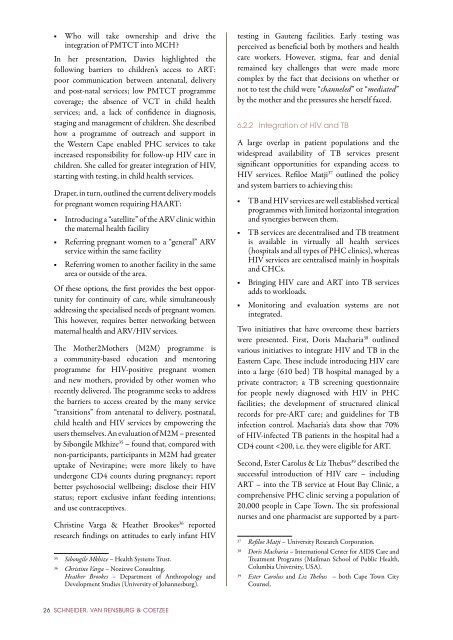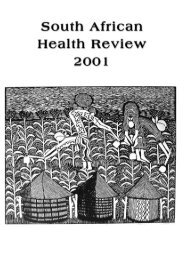Round Table Report - UCT Main - University of Cape Town
Round Table Report - UCT Main - University of Cape Town
Round Table Report - UCT Main - University of Cape Town
You also want an ePaper? Increase the reach of your titles
YUMPU automatically turns print PDFs into web optimized ePapers that Google loves.
■■<br />
Who will take ownership and drive the<br />
integration <strong>of</strong> PMTCT into MCH?<br />
In her presentation, Davies highlighted the<br />
following barriers to children’s access to ART:<br />
poor communication between antenatal, delivery<br />
and post-natal services; low PMTCT programme<br />
coverage; the absence <strong>of</strong> VCT in child health<br />
services; and, a lack <strong>of</strong> confidence in diagnosis,<br />
staging and management <strong>of</strong> children. She described<br />
how a programme <strong>of</strong> outreach and support in<br />
the Western <strong>Cape</strong> enabled PHC services to take<br />
increased responsibility for follow-up HIV care in<br />
children. She called for greater integration <strong>of</strong> HIV,<br />
starting with testing, in child health services.<br />
Draper, in turn, outlined the current delivery models<br />
for pregnant women requiring HAART:<br />
■■<br />
■■<br />
■■<br />
Introducing a “satellite” <strong>of</strong> the ARV clinic within<br />
the maternal health facility<br />
Referring pregnant women to a “general” ARV<br />
service within the same facility<br />
Referring women to another facility in the same<br />
area or outside <strong>of</strong> the area.<br />
Of these options, the first provides the best opportunity<br />
for continuity <strong>of</strong> care, while simultaneously<br />
addressing the specialised needs <strong>of</strong> pregnant women.<br />
This however, requires better networking between<br />
maternal health and ARV/HIV services.<br />
The Mother2Mothers (M2M) programme is<br />
a community-based education and mentoring<br />
programme for HIV-positive pregnant women<br />
and new mothers, provided by other women who<br />
recently delivered. The programme seeks to address<br />
the barriers to access created by the many service<br />
“transitions” from antenatal to delivery, postnatal,<br />
child health and HIV services by empowering the<br />
users themselves. An evaluation <strong>of</strong> M2M – presented<br />
by Sibongile Mkhize 35 – found that, compared with<br />
non-participants, participants in M2M had greater<br />
uptake <strong>of</strong> Nevirapine; were more likely to have<br />
undergone CD4 counts during pregnancy; report<br />
better psychosocial wellbeing; disclose their HIV<br />
status; report exclusive infant feeding intentions;<br />
and use contraceptives.<br />
Christine Varga & Heather Brookes 36 reported<br />
research findings on attitudes to early infant HIV<br />
35 Sibongile Mkhize – Health Systems Trust.<br />
36 Christine Varga – Nozizwe Consulting.<br />
Heather Brookes – Department <strong>of</strong> Anthropology and<br />
Development Studies (<strong>University</strong> <strong>of</strong> Johannesburg).<br />
testing in Gauteng facilities. Early testing was<br />
perceived as beneficial both by mothers and health<br />
care workers. However, stigma, fear and denial<br />
remained key challenges that were made more<br />
complex by the fact that decisions on whether or<br />
not to test the child were “channeled” or “mediated”<br />
by the mother and the pressures she herself faced.<br />
6.2.2 Integration <strong>of</strong> HIV and TB<br />
A large overlap in patient populations and the<br />
widespread availability <strong>of</strong> TB services present<br />
significant opportunities for expanding access to<br />
HIV services. Refiloe Matji 37 outlined the policy<br />
and system barriers to achieving this:<br />
■■ TB and HIV services are well established vertical<br />
programmes with limited horizontal integration<br />
and synergies between them.<br />
■■ TB services are decentralised and TB treatment<br />
is available in virtually all health services<br />
(hospitals and all types <strong>of</strong> PHC clinics), whereas<br />
HIV services are centralised mainly in hospitals<br />
and CHCs.<br />
■■ Bringing HIV care and ART into TB services<br />
adds to workloads.<br />
■■ Monitoring and evaluation systems are not<br />
integrated.<br />
Two initiatives that have overcome these barriers<br />
were presented. First, Doris Macharia 38 outlined<br />
various initiatives to integrate HIV and TB in the<br />
Eastern <strong>Cape</strong>. These include introducing HIV care<br />
into a large (610 bed) TB hospital managed by a<br />
private contractor; a TB screening questionnaire<br />
for people newly diagnosed with HIV in PHC<br />
facilities; the development <strong>of</strong> structured clinical<br />
records for pre-ART care; and guidelines for TB<br />
infection control. Macharia’s data show that 70%<br />
<strong>of</strong> HIV-infected TB patients in the hospital had a<br />
CD4 count

















